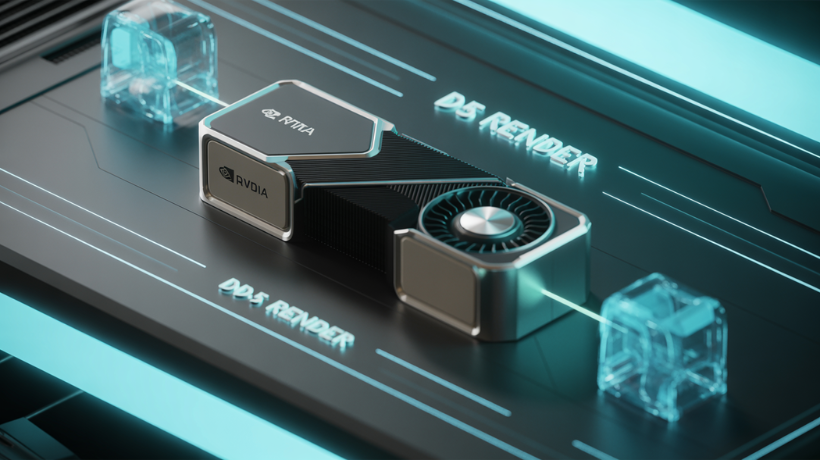If you’re serious about 3D rendering, you know that RAM matters. It keeps your scenes smooth and your renders fast. But with so many choices, how do you pick the best RAM for 3D rendering?
In this guide, we’ll compare speed, capacity, and overall performance. You’ll find out what makes a real difference—and how to avoid wasting money.

Why RAM Matters in 3D Rendering
RAM is where your system stores working data. When you render, your computer loads textures, geometry, lighting, and cache into memory. Without enough RAM, your project will lag or crash.
But more RAM isn’t always better. You need the right mix of speed, size, and quality.
How Much RAM Do You Need?
It depends on your projects. But here’s a rough guide:
- 16GB: Entry-level scenes with simple assets
- 32GB: Most common for mid-sized projects
- 64GB: Ideal for large, complex scenes
- 128GB+: Needed for simulations or film-quality work
If your scenes grow over time, plan for more.
Also, rendering software like Blender, Maya, and Cinema 4D can use a lot of memory, especially during final render stages.
RAM Speed vs Capacity: Which Matters More?
Both are important. But for 3D rendering, capacity often comes first.
Large files and detailed models need space. But once you pass the safe range, speed starts to matter more. Fast RAM improves data handling between CPU and memory.
For best results:
- Choose higher speed (e.g., DDR5-5600 or DDR4-3600)
- Match RAM speed with your motherboard support
- Use dual or quad channel setups
ECC vs Non-ECC RAM for 3D Work
ECC (Error-Correcting Code) RAM fixes memory errors. It’s used in servers and workstations. While it adds stability, it’s also more expensive.
Non-ECC RAM works fine for most freelancers and small studios.
Use ECC if:
- You render 24/7
- You run a render farm
- You use mission-critical workflows
Otherwise, non-ECC is more affordable and widely supported.
Best RAM for 3D Rendering in 2025
Let’s explore some top RAM kits trusted by artists and studios.
1. Corsair Vengeance DDR5 64GB (2x32GB) 6000MHz
- High speed for modern CPUs
- Great balance of cost and power
- Compatible with most Intel and AMD builds
Best for: Mid to high-end Blender or Maya users
2. G.Skill Trident Z5 RGB DDR5 64GB 6400MHz
- Stylish design and performance
- Supports XMP for easy overclocking
- Ideal for rendering and gaming builds
Best for: Designers who multitask or stream
3. Kingston Fury Beast DDR4 64GB 3600MHz
- Affordable, reliable DDR4 kit
- Strong performance on older systems
- Still powerful for 3D workflows
Best for: Budget-conscious creators
4. Crucial ECC Registered DDR4 128GB 3200MHz
- Built for workstations and render farms
- Supports ECC for stability
- Works with Threadripper and Xeon platforms
Best for: Pro studios and large scene rendering
5. TeamGroup T-Force Delta RGB DDR5 32GB 6000MHz
- Entry DDR5 for new rigs
- Good price for speed
- Syncs with motherboard lighting
Best for: New 3D artists building their first system
Dual Channel vs Quad Channel RAM
The more memory channels, the better the bandwidth. Most motherboards support dual-channel. Some workstation boards offer quad.
For best performance:
- Use identical RAM sticks
- Install in matching slots
- Avoid mixing brands or speeds
Also, check your BIOS to make sure XMP or DOCP is enabled.
RAM for GPU vs CPU Rendering
GPU rendering (like with Octane or Redshift) uses VRAM. But system RAM still matters.
In GPU rendering:
- System RAM handles scene data
- More RAM = smoother viewport and file handling
In CPU rendering:
- RAM is used for all calculations
- Too little RAM can crash your render
So, regardless of your renderer, don’t skimp on RAM.
How to Future-Proof Your RAM
- Pick higher capacity kits (32GB or 64GB)
- Go for DDR5 if supported
- Buy quality brands with heat spreaders
- Leave empty RAM slots for upgrades
Also, plan for your software updates. Newer versions often need more memory.
>>> Read more: A Beginner’s Guide to Texture Mapping in 3D
Final Thoughts on Choosing the Best RAM for 3D Rendering
The best RAM for 3D rendering balances speed, stability, and size. Start with 32GB if you’re learning. Go to 64GB+ for client work. Use 128GB+ for simulations or high-end film work.
Fast RAM helps. But stability and capacity matter more. So, invest smart, and match your RAM with your CPU and motherboard.
Render Faster with 3S Cloud Render Farm
Even with the best RAM, some renders take time. Offload your projects to 3S Cloud Render Farm and save hours.
It supports Blender, Maya, 3ds Max, and more.